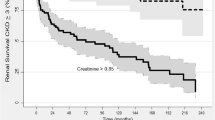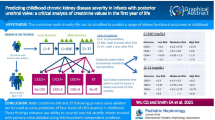Abstract
Background
Early kidney and anatomic features may be predictive of future progression and need for additional procedures in patients with posterior urethral valve (PUV). The objective of this study was to use machine learning (ML) to predict clinically relevant outcomes in these patients.
Methods
Patients diagnosed with PUV with kidney function measurements at our institution between 2000 and 2020 were included. Pertinent clinical measures were abstracted, including estimated glomerular filtration rate (eGFR) at each visit, initial vesicoureteral reflux grade, and renal dysplasia at presentation. ML models were developed to predict clinically relevant outcomes: progression in CKD stage, initiation of kidney replacement therapy (KRT), and need for clean-intermittent catheterization (CIC). Model performance was assessed by concordance index (c-index) and the model was externally validated.
Results
A total of 103 patients were included with a median follow-up of 5.7 years. Of these patients, 26 (25%) had CKD progression, 18 (17%) required KRT, and 32 (31%) were prescribed CIC. Additionally, 22 patients were included for external validation. The ML model predicted CKD progression (c-index = 0.77; external C-index = 0.78), KRT (c-index = 0.95; external C-index = 0.89) and indicated CIC (c-index = 0.70; external C-index = 0.64), and all performed better than Cox proportional-hazards regression. The models have been packaged into a simple easy-to-use tool, available at https://share.streamlit.io/jcckwong/puvop/main/app.py
Conclusion
ML-based approaches for predicting clinically relevant outcomes in PUV are feasible. Further validation is warranted, but this implementable model can act as a decision-making aid.
Graphical abstract
A higher resolution version of the Graphical abstract is available as Supplementary information




Similar content being viewed by others
Code availability
Code used in this study is available upon request to the corresponding author.
References
de Bessa J, de Carvalho Mrad FC, Mendes EF, Bessa MC et al (2015) Antibiotic prophylaxis for prevention of febrile urinary tract infections in children with vesicoureteral reflux: a meta-analysis of randomized, controlled trials comparing dilated to nondilated vesicoureteral reflux. J Urol 193:1772–1777
Bilgutay AN, Roth DR, Gonzales ET Jr, Janzen N et al (2016) Posterior urethral valves: risk factors for progression to renal failure. J Pediatr Urol 12:179.e1–7
Vasconcelos MA, e Silva ACS, Dias CS, Gomes IR, et al (2019) Posterior urethral valves: comparison of clinical outcomes between postnatal and antenatal cohorts. J Pediatr Urol 15:167.e1-167.e8
Parkhouse HF, Barratt TM, Dillon MJ, Duffy PG et al (1988) Long-term outcome of boys with posterior urethral valves. Br J Urol 62:59–62
Duckett JW (1997) Are ‘valve bladders’ congenital or iatrogenic? Br J Urol 79:271–275
McLeod DJ, Szymanski KM, Gong E, Granberg C et al (2019) Renal replacement therapy and intermittent catheterization risk in posterior urethral valves. Pediatrics 143:e20182656
Katsoufis CP (2020) Clinical predictors of chronic kidney disease in congenital lower urinary tract obstruction. Pediatr Nephrol 35:1193–1201
Lopez Pereira P, Espinosa L, Martinez Urrutina MJ, Lobato R et al (2003) Posterior urethral valves: prognostic factors. BJU Int 91:687–690
Keays MA, McAlpine K, Welk B (2018) All grown up: a transitional care perspective on the patient with posterior urethral valves. Can Urol Assoc J 12:S10
Ansari MS, Surdas R, Barai S, Srivastava A et al (2011) Renal function reserve in children with posterior urethral valve: a novel test to predict long-term outcome. J Urol 185:2329–2333
Herbst KW, Tomlinson P, Lockwood G, Mosha MH et al (2019) Survival and kidney outcomes of children with an early diagnosis of posterior urethral valves. Clin J Am Soc Nephrol 14:1572–1580
Zheng Q, Furth SL, Tasian GE, Fan Y (2019) Computer-aided diagnosis of congenital abnormalities of the kidney and urinary tract in children based on ultrasound imaging data by integrating texture image features and deep transfer learning image features. J Pediatr Urol 15:75-e1
Bertsimas D, Li M, Estrada C, Nelson C, Scott Wang HH (2021) Selecting children with vesicoureteral reflux who are most likely to benefit from antibiotic prophylaxis: application of machine learning to RIVUR. J Urol 205:1170–1179
Abdovic S, Cuk M, Cekada N, Milosevic M et al (2019) Predicting posterior urethral obstruction in boys with lower urinary tract symptoms using deep artificial neural network. World J Urol 37:1973–1979
Lorenzo AJ, Rickard M, Braga LH, Guo Y et al (2019) Predictive analytics and modeling employing machine learning technology: the next step in data sharing, analysis, and individualized counseling explored with a large, prospective prenatal hydronephrosis database. Urology 123:204–209. https://doi.org/10.1016/j.urology.2018.05.041
Schwartz GJ, Muñoz A, Schneider MF, Mak RH et al (2009) New equations to estimate GFR in children with CKD. J Am Soc Nephrol 20:629–637. https://doi.org/10.1681/ASN.2008030287
Ishwaran H, Kogalur UB, Blackstone EH, Lauer MS (2008) Random survival forests. Ann Appl Stat 2:841–860
Smith GHH, Canning DA, Schulman SL, Snyder HM 3rd, Duckett JW (1996) The long-term outcome of posterior urethral valves treated with primary valve ablation and observation. J Urol 155:1730–1734
DeFoor W, Clark C, Jackson E, Reddy P et al (2008) Risk factors for end stage renal disease in children with posterior urethral valves. J Urol 180:1705–1708
Holmdahl G, Sillen U, Hellström A-L, Sixt R, Sölsnes E (2003) Does treatment with clean intermittent catheterization in boys with posterior urethral valves affect bladder and renal function? J Urol 170:1681–1685
Richter AN, Khoshgoftaar TM (2018) A review of statistical and machine learning methods for modeling cancer risk using structured clinical data. Artif Intell Med 90:1–14
Dipchand A, Westreich KD, Filler G (2016) How to estimate glomerular filtration rate (GFR) in pediatric cardiac patients. Prog Pediatr Cardiol 41:3–8
Pierce CB, Muñoz A, Ng DK, Warady BA et al (2021) Age-and sex-dependent clinical equations to estimate glomerular filtration rates in children and young adults with chronic kidney disease. Kidney Int 99:948–956
Ansari MS, Nunia SK, Bansal A, Singh P et al (2018) Bladder contractility index in posterior urethral valve: a new marker for early prediction of progression to renal failure. J Pediatr Urol 14:162-e1
Vieira ÉLM, Rocha NP, Bastos FM, da Silveira KD et al (2017) Posterior urethral valve in fetuses: evidence for the role of inflammatory molecules. Pediatr Nephrol 32:1391–1400
Author information
Authors and Affiliations
Contributions
All authors contributed to project development, data collection, data analysis, and manuscript writing.
Corresponding author
Ethics declarations
Research involving human participants
This retrospective chart review study involving human participants was in accordance with the ethical standards of the institutional and national research committee and with the 1964 Helsinki Declaration and its later amendments or comparable ethical standards. The Research and Ethics Board of The Hospital for Sick Children approved this study.
Informed consent
Due to the retrospective nature of this study, informed consent was not required.
Competing interests
The authors declare no competing interests.
Additional information
Publisher's Note
Springer Nature remains neutral with regard to jurisdictional claims in published maps and institutional affiliations.
Supplementary Information
Below is the link to the electronic supplementary material.
Rights and permissions
About this article
Cite this article
Kwong, J.C., Khondker, A., Kim, J.K. et al. Posterior Urethral Valves Outcomes Prediction (PUVOP): a machine learning tool to predict clinically relevant outcomes in boys with posterior urethral valves. Pediatr Nephrol 37, 1067–1074 (2022). https://doi.org/10.1007/s00467-021-05321-3
Received:
Revised:
Accepted:
Published:
Issue Date:
DOI: https://doi.org/10.1007/s00467-021-05321-3




